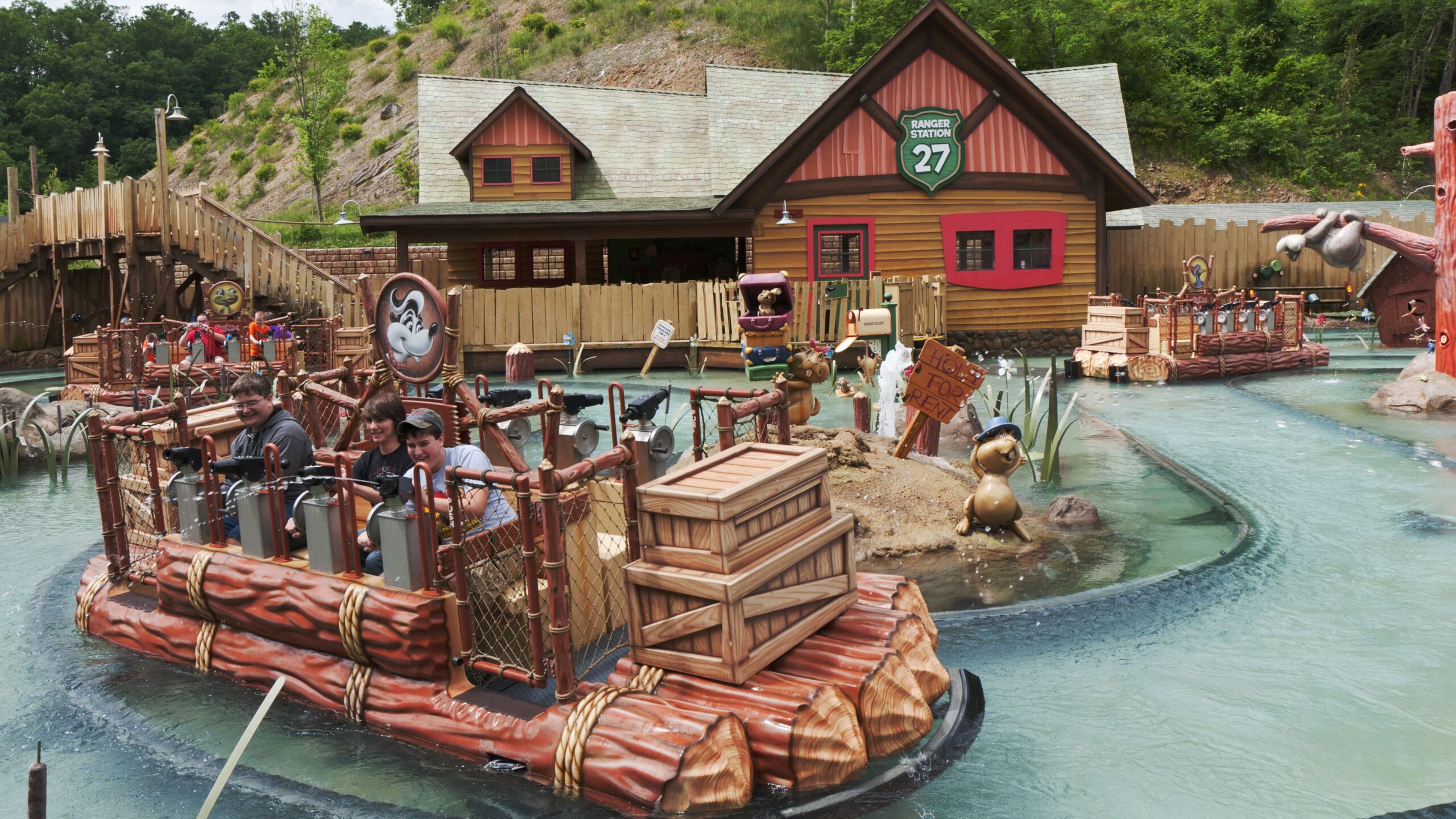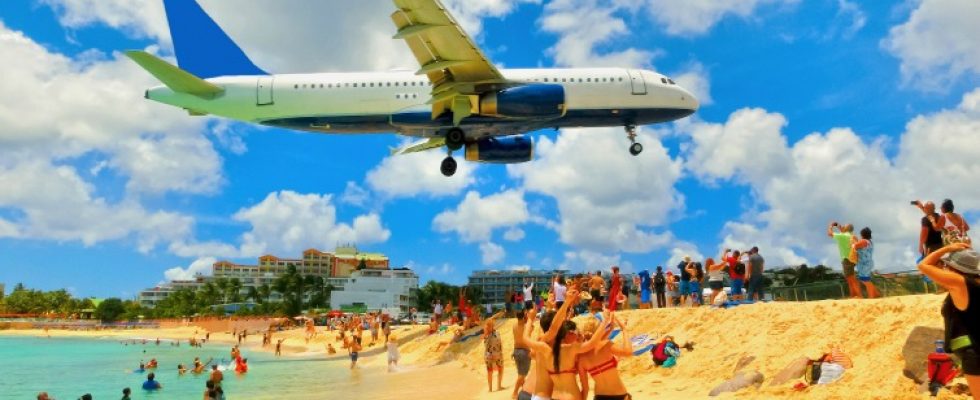
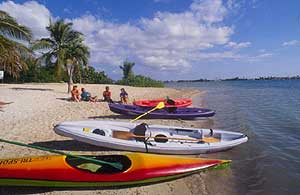
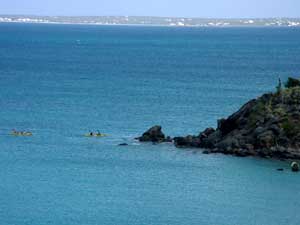
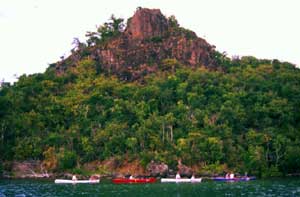
Ahh! Stable ground. Fresh off the Grand Princess cruise ship I took in the salty and humid early morning air as I strolled along the squeaky clean sidewalk at the A.C. Wathey Pier at Pointe Blanche, in Dutch Sint Maarten.
Sint Maarten is the world’s smallest land mass that is home to two sovereign nations…Dutch on the south side and French on the north. Sint Maarten is part of the Netherland Antilles, along with Curacoa, Bonaire, Saba, and St. Eustatuis. St. Martin is part of the French overseas Department, governed by Guadelope. Dutch Sint Maarten is bustling with the traffic generated by the cruise ships and the Princess Juliana International Airport. French St. Martin stays to itself…the culture and cuisine that is French is abundant there.
As I was corralled into the “Group C” sea kayakers’ spot on the sidewalk, I took a peak at the ocean to my left. Although still a touch gray under the rising sun, the water seemed to beckon me with the promise of turquoise colors and warm temperatures. The sense of hope afforded me the strength, after a late night on the cruise ship, to keep up with the group as we made our way to the bus that would take us to well-known Simpson Bay.
The small shopping pavilion at the port was reflective of Dutch architecture, with soft pastels and wooden eaves, notably clean and neat. The sights I digested that morning reminded me that I was, indeed, partaking in international travel.
My husband and I hopped on the bus and cruised along while we took in the surprising vistas of low, arid terrain covered in desert vegetation. So this is a Caribbean island, I thought to myself? (Our upcoming sea kayaking adventure would soon confirm that it is indeed.) Diane Scott, of Tri-Sport Outdoor Activities, provided an informational history brief of Dutch Sint Maarten and French St. Martin along the way. She dispensed just enough material to spark my curiosity of the island’s unique background. A short and pleasant bus ride away, we arrived at an old resort on Simpson Bay Lagoon.
Simpson Bay is one of the largest landlocked bodies of water in the Caribbean. Located on the southwestern side of the island, narrow isthmuses rim Simpson Bay. The lagoon is part Dutch, part French and is known as the busiest water sport center on the south side of the island. Diane explained that in the summer months there are hundreds of boats in the lagoon, making for more of an adventure for kayakers. Simpson Bay Lagoon offers tranquil waters for kayaking, especially in the fall months when the boaters are in hibernation.
Our kayaking adventure began with a quick lesson on paddling by avid triathlete, Malcom, the founder of Tri-Sport of Sint Maarten. Tri-Sport is not only an adventure outfitter, but, as I was told, is THE retail outlet for outdoors sporting gear on the island. Diane and Felipe also joined us as our guides around the lagoon. From start to finish they were excellent teachers, guides, and hosts.
My husband and I decided on the tandem kayak, despite the legend that it’s the “divorce kayak”! The first 10 minutes on the water were critical. We proceeded to delicately tell the other how to kayak, until we realized that, what do you know, we were both doing something right…we were leading the pack! Before we knew it we were paddling like a team, our hearts were beating steadily, we were taking in the view, and we were half way to Explorer Island, our destination for the day.
At Explorer Island we had our choice of swimming in the clear waters, diving off the rustic floating platform, lounging, or playing paddleball. Pumped up by the thrill of the open water, and the stimulation of rich exercise, we choose all but the lounging.
We paddled up to the shores of Mt. Fortune for a short time, then, paddled adjacent to the Conch Cemetery, that is based on a local legend. After a momentary glimpse at the Conch Cemetery we headed back out on the water to kayak towards our next stop…the mangroves. It is here that we encountered a bit of wildlife. The mangroves provide shelter and nourishment to many sea creatures, including the sea cucumber and the Upside-down Jellyfish. Fortunately, we were able to locate and palm both. I never knew you could hold a jellyfish without experiencing a great deal of pain, but indeed you can. These jellyfish just need to be held…held correctly that is. They must be held from the bottom, not the top where the stingers are located. The lofty and intriguing sea cucumbers, on the other hand, can be handled more enthusiastically. Although your imagination might roam, in the end you’ll decide they do indeed look like cucumbers.
Our kayak back to the resort was challenged by the requirement of staying clear of the “sinking sands”, the sand bar made of drudged up sand excavated to create Simpson Bay Lagoon years ago.
Back at our starting point we were rewarded with Carib beers and relaxed chat with the refreshingly hospitable staff of Tri-Sport. I watched overhead as the frigate birds flew past and realized just how content, carefree, and relaxed I was, thanks to the crew of Tri-Sport.
We were exhilarated and starving by the time we returned to the port. Even after a fulfilling kayak expedition we still had time to eat, lounge on the beach, and shop. Excellent! We had to taste the conch fritters, one of the signatures of the island. Our visit to a sidewalk café in downtown Philipsburg was required. Despite the fact that the conch fritters were a bit pricey and seemed a bit void of the conch component, our tasting was well worth the experience. We learned that next time we’ll search out the best conch fritters on the island, with the help of the locals.
After filling our bellies we swam, lounged on the beach, and then headed to the streets of Philipsburg for shopping. Philipsburg is the capital of the Dutch side and is plentiful with duty free shops, resorts, favorable restaurants and gambling casinos. Philipsburg, built on a sandy strip parallel to Great Bay, is only about 4 streets wide. The main streets are Front Street and Back Street, lined with fine boutiques. Front Street offers narrow alleys or “steegjes”. Old Street is a gated road that connects Front and Back Street. The town also lays claim to the historical Great Salt Pound, which once providing a splendid economy for Sint Maarten.
Colonial Dutch and West Indian architecture abounds in Philipsburg, exhibiting gingerbread designs, porches, rooftops, and pastels. A fantastic example of this is the Pasasgrhan Inn along Front Street. The white and green Court House on Front Street, built in 179, is sought out by many. Simartin Museum, built in 1989, is the place to learn of the history and geology of the island.
You can certainly stay adventurously busy in Sint Maarten, windsurfing, jet skiing, boogie boarding, hiking, mountain biking, or horseback riding. Divers can scuba dive at one of the 30 dive sites in the Atlantic and Caribbean oceans. Waters remain at approximately 70 degrees Fahrenheit year round with excellent visibility, whenever tropical storms are not threatening. You have your choice of pristine coral reefs or several shipwrecks to encounter, including the British frigate Proselyte wreck that sank in 1801. Its visible from the surface of the water, so snorkelers can get involved there as well. The Hens and Rocks dive area offers a 70-foot drop off, perfect for experienced divers.
You, too, can be a guest of Sint Maarten. You can cruise into port, like I did, or take a flight on one of several major airlines. You’ll need your passport, birth certificate, or voter registration card with a photo I.D.
The official currency on the island is the Euro, but the dollar is accepted everywhere.
Remember that restaurants add a 10-15% service charge to the bill, in place of a tip. Leave more of the green stuff only if it’s merited.
Transportation around Sint Maarten is easy. There is one major road around the island. You can rent a car, jeep, motorcycle, or scooter from most major rental companies.
Tri-Sport is highly recommended as your adventure outfitter while in Sint Maarten. Here’s how to reach them:
Telephone: 599-545-4384
Fax: 599-545-4385
Email: trisport@caribserve.net
Alluring, turquoise water, soothing rolling waves, and dynamic activities are the things people dream of, until their dreams come true in Dutch Sint Maarten.
A Brief History of Sint Maarten
The island of Sint Maarten/St. Martin was spotted by Columbus during his 2nd voyage in 1493. The date was November 11, the designated Feast Day of St. Martin of Tours, which gave the new land its name.
Early inhabitants of the area were Arawak Indians, a peaceful people, in the small islands of the Lesser Antilles. The Carib people followed and referred to the landmass as “Sualougia” or “a place to get salt.”
The Spanish, French, and Dutch sought the natural salt ponds found on Sint Maarten as early as the 1600’s. The Dutch, namely, needed the salt to preserve the herring they were shipping back to Holland. The Dutch got there first, and claimed it in 1631. The salt ponds were put into working order as a saltern, and were in use till 1949. Although it is partly filled in today, it remains home to wildlife such as herons and migrating birds.
Fort Amsterdam, erected in 1631 and captured by the Spanish thereafter, is the oldest Dutch Fort in the Caribbean. It is a 20-minute walk from Front Street. Curious visitors can view the ruins from Pointe Blanche on the eastern shore of the bay.
Sugarcane plantations were established on Sint Maarten in the late 1700’s. Slaves were used to maintain the plantations. Once slavery was abolished later in the century, the sugarcane industry collapsed. In the years to come, slaves intermarried to eventually form the Creole culture of today. All the while the French staked their claim on the northern part of the island.
In the 1940’s Princess Julianna Airport was built. The port at Great Bay was quickly developed and became the largest port in the Lesser Antilles, and contributed to the booming tourism industry in Sint Maarten today.
Get More Information on This Adventure!!!
Experience adventures like the one found in this article and others by using TropicalAdventure.com Vacation Planner. Simply fill out our Vacation Planner form and you will receive FREE information about this activity and others that you may be interested in. Click below to sign up.

